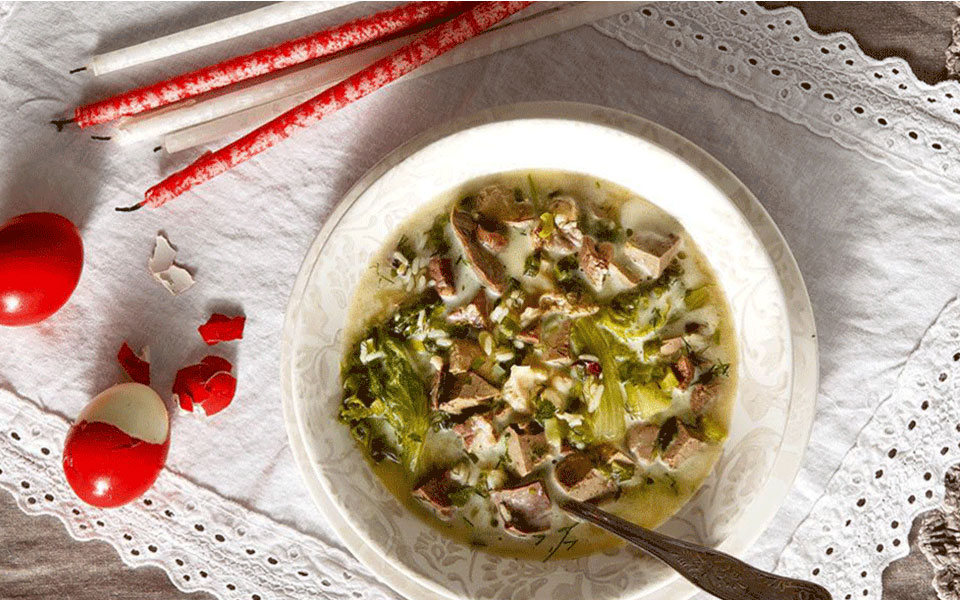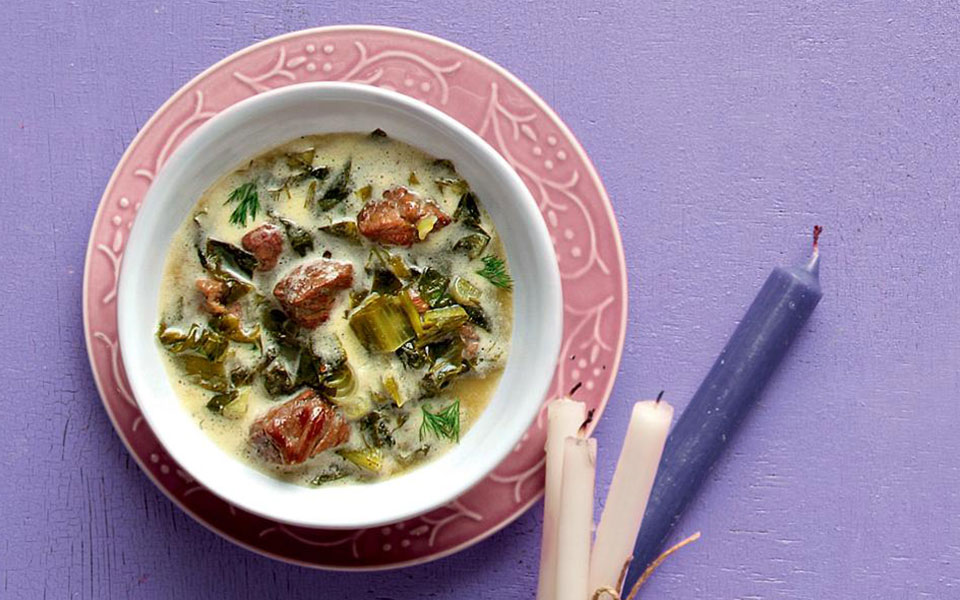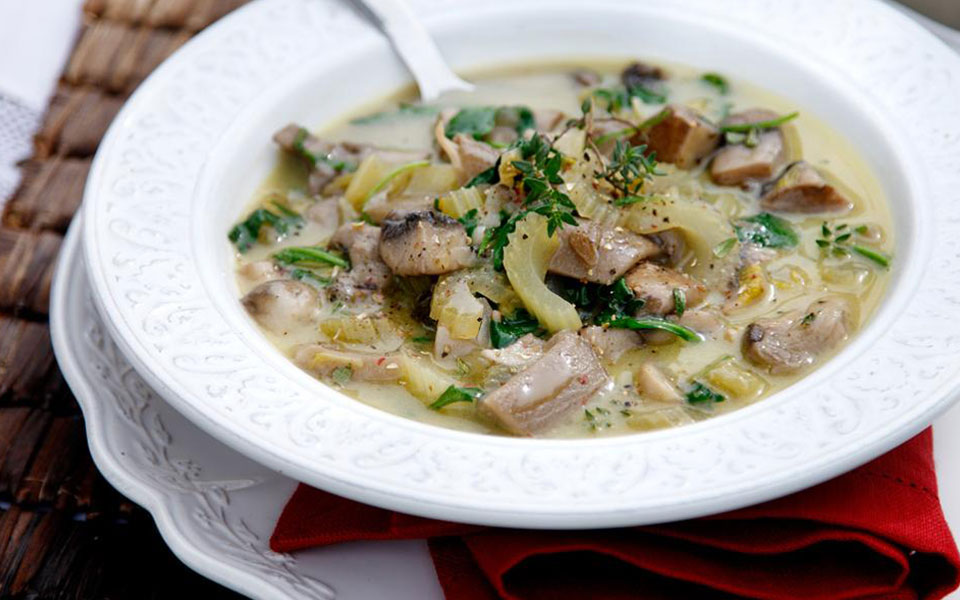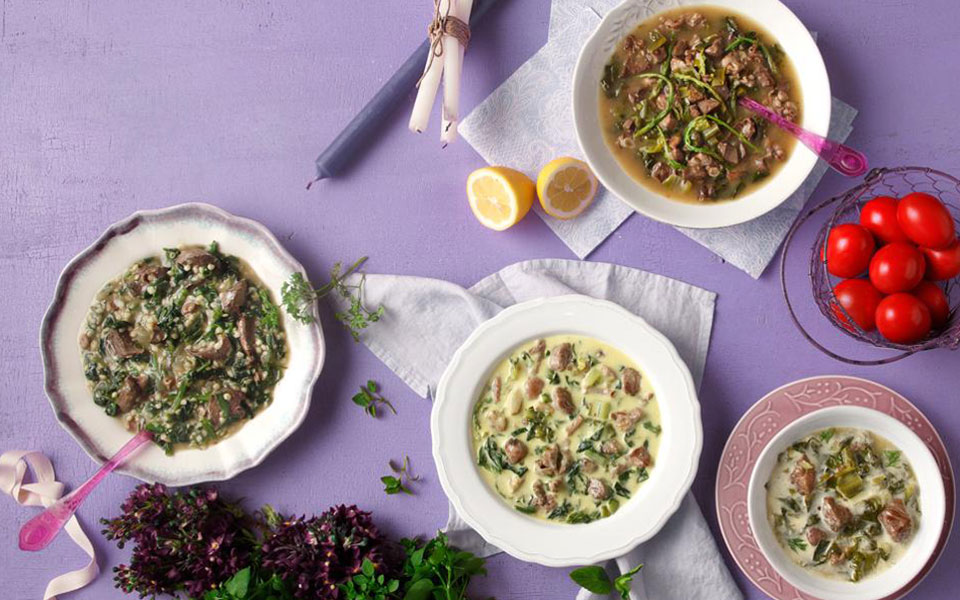While for many Greeks eating magiritsa is a high point of Easter, it’s safe to say that for the uninitiated a bowl of the stuff can be a rather daunting prospect.
Traditionally eaten in the early hours of Easter Sunday following the midnight service celebrating the Resurrection, magiritsa is the rich soup with which the faithful break their Lent fast. It is typically made with lamb liver and other organs such as the lungs, heart and spleen (collectively this is known as sykotaria in Greek) as well as lamb intestines, plentiful dill and a roughly chopped head of lettuce. Another hallmark of the soup is the egg-lemon liaison added at the end. (This is also one of the trickiest parts of the soup to get right, as if the egg is added to the hot soup too quickly, the proteins will denature. The goal is for the liaison to retain its silky-smooth texture.)
But even if you don’t like lamb offal, or your guests / children / significant others don’t, that doesn’t mean you have to forgo the magiritsa tradition entirely. Below, together with the traditional recipe, you’ll find two other recipes for modernized versions: one with beef in the place of the lamb offal, and the other a vegetarian version using a delicious and hearty mix of mushrooms.
Kalo Pascha!

© George Drakopoulos
The Traditional
Recipe by Varvara Nteladaki-Kokkini
In large stock pot heat plenty of salted water to a rolling boil and add the lamb liver and organs (not the intestine) and cook for about 2-3 minutes until they changes color and soften. Strain the meat and discard the water.
In the same, now empty pan, heat the oil on a medium head and sauté the onions with the lettuce and a little salt for about 2 minutes until they are soft and shrink in size.
Add the lamb liver and organs, the small intestine, the dill and the parsley and continue to sauté for 3-4 minutes, stirring the ingredients with a wooden spoon until they are covered in oil. Add salt and pepper and pour in the wine. Let the mixture cook for 2-3 minutes until the alcohol has evaporated.
Add 1 liter of water and cook for 1 hour until the ingredients have softened.
(Note that at this stage you can ‘pause’ the soup. Many Greeks prepare the soup to this stage and then let it cool and head to church on Holy Saturday. When they return home they add the rice and complete the soup with the egg-lemon liaison.)
Add the rice and continue cooking for 20 minutes until the rice is cooked.
In a bowl whisk the egg whites with the vinegar and a little salt until it forms a stiff meringue. In another bowl, beat the yolks with the lemon juice until light in color and frothy. Add the meringue, mix and gradually add broth from the soup with a spoon to the egg, mixing continuously so that the mixture gradually warms up. Then empty the egg-lemon into the mageiritsa, and shake the pan so it mixes in. Let it rest for 5 minutes for the flavors to combine and serve.
What to drink with it: a Gewurstraminer or a Riesling
*In Greece mageiritsa is traditionally made with sykotaria – the liver of a lamb together with other organs including the heart, lungs and spleen.
** Cleaning the Intestine
The night before place the intestines in a bowl and cover them with water, squeeze the juice of a lemon into the water (to whiten them) and place it in the fridge.
The next day take one end of the intestine, stretch the opening with your fingers and place the opening under the running tap. Allow plenty of water to flow in and then, squeezing the intestine, (it will swell like a balloon) push the water down towards the other end. Repeat the procedure a number of times until the water that comes out of the other end is clean.
Ingredients (Serves 6):
- 1.5 kg lamb liver and other organs* cut into cubes (about 2-3cm)
- 1 small intestine (about 300gr), well cleaned** and cut into 3-4cm pieces
- 1 bunch dill finely chopped (remove any thick stems)
- 1 bunch parsley finely chopped (remove any thick stems)
- 1 large head of lettuce, washed and coarsely chopped
- 5 spring onions finely chopped
- 150ml white, dry wine
- 150ml olive oil
- 100g glutinous rice
- 2 eggs, yolks and whites separated
- 1 tbsp vinegar
- The juice of 1 lemon (or to taste)
- Salt and freshly ground pepper

© George Drakopoulos
Ingredients (Serves 6):
- 1 kg beef (chuck steak) cut into 2-3 cm cubes
- 1 large lettuce, washed and coarsely chopped
- 1 bunch of spring onions finely chopped (both the white and tender green parts)
- 1 bunch of dill finely chopped (remove any thick stems)
- 1 bunch of parsley finely chopped (remove any thick stems)
- 100 ml dry white wine
- salt, freshly ground pepper
- the juice of 2 lemons (or to taste)
- 2 egg yolks
- 2 tbsp of cornflour
- 80 ml olive oil
The Beginner-Friendly
Recipe by Evdokia Filakouri & Niki Tressou
In a large stock pot sauté the onions on a medium heat until wilted, add in the beef and continue sautéing until browned.
Pour in the wine and let the alcohol evaporate for two minutes. Add salt and pepper and cover with water by 2-3 cm. Boil for about 50 minutes or until the meat is tender. In the last 15 minutes add the lettuce. If necessary, add more water.
Beat the egg yolks in a bowl with the cornflour and lemon, and slowly add 200ml of the broth from the soup with a spoon. Beat the mixture and pour it into the soup, stirring continuously. Add the dill, mix and remove it from the heat.
What to drink: A barrel-aged Chardonnay, or a Nykteri – wines with body and intensity.

© George Drakopoulos
The Vegetarian
Recipe by Christoforos Peskias
In recent years, more and more people are eschewing the rich offal of traditional magiritsa and turning to veggie-only versions. The recipe below is a particularly tasty one, making use of a wide variety of mushrooms, replacing the traditional lettuce with rocket and using a wider variety of spices for added flavor.
Wipe the mushrooms with a damp cloth to clean them of any dirt. Remove the hard stalks from the oyster mushrooms and cut the bottom parts of the button and portobello mushrooms if they are tough.
Cut the button mushrooms into halves if they are small, or quarters if they are on the larger side, and cut the oyster and portobello mushrooms into cubes. If you are using chanterelles and horn of plenty mushrooms, leave them intact as they are small and have nice shapes.
In a large stock pot sauté the onion, garlic and celery with 2 tablespoons of the oil, on a medium heat for 4-5 minutes or until they soften. Add the wine, the bayleaf and the thyme and continue cooking.
At the same time, in a large frying pan on a very high heat sauté the mushrooms in batches, first the button mushrooms, then the portobello and finally the oyster mushrooms – cooking each type for 4-5 minutes until browned. When each batch has been cooked, add them to the saucepan.
After sautéing the three types of mushroom and adding them to the pot, add enough water to cover them well and let simmer on a low heat for about 20 minutes. From time to time skim off any foam (with a serving, not slotted spoon).
After 20 minutes add the horn of plenty mushrooms and the chanterelles (if you are using them), the ground coriander and ginger. Cook for another 10 minutes. If necessary add more hot water to just cover the mushrooms (be careful not to add too much or the soup will become bland).
After 10 minutes add the rocket and remove the soup from the heat.
Beat the eggs with the lemon juice in a bowl. Add, in small doses, a fair amount of the warm broth from the soup in order to slowly warm up the egg-lemon mixture and then add it to the soup. Shake the pot so that the egg-lemon liaison spreads evenly, add salt and pepper to taste, and serve.
What to drink with it: A rich, white wine! A Sauvignon, Malagouzia, Mantineia, Traminer or cool Debina.
The recipes above were first published in Greek by gastronomos.gr
Ingredients (Serves 6-8)
- 500 g white button mushrooms cut into halves or quarters depending on their size
- 500 g portobello mushrooms
- 500 g oyster mushrooms
- 500 g horn of plenty mushrooms (These are also known as black trumpet mushrooms on account of their color and shape. They have a delicate and slightly smoky flavor. If you can’t find them however increase the amounts of the other types of mushrooms.)
- 500 g chanterelle mushrooms (golden-yellow colored mushrooms with a light fruity aroma reminiscent of apricots. Again if you can’t get your hands on any increase the amount of the other types of mushrooms – you want a total of 2.5 kg),
- 80 ml olive oil
- 1 large onion, finely chopped
- 5 cloves of garlic, finely chopped (or to taste)
- 2 stalks of celery, finely chopped
- 250 ml white wine
- 1 bay leaf
- The leaves of half a bunch of fresh thyme, or 1 tsp dried
- 1 tsp coriander seeds ground into a powder in a pestle mortar
- 1 tsp ground ginger
- 2 bunches of rocket with the thicker stems removed, coarsely chopped
- 5-6 eggs, preferably organic
- The juice from 1 lemon (or to taste)
- Salt & freshly ground pepper












